Best of India Tours
- Golden Triangle Tour- Best of India & Nepal
- Classical Rajasthan
India Cultural Tours
- Images of North India- Karnataka Heritage
- Rajasthan & Goa Tour
Discover India Tours
- Grand India Tour- North to South India
- Central to South India
Rajasthan Tours
- Classical Rajasthan Tour- Golden Triangle Tour
- Grand Mughal Tour
India Luxury Trains
- Palace on Wheels- The Golden Chariot
- India Deccan Odyssey
- The Indian Maharaja
- Royal Rajasthan on Wheels
Nepal Tours
- Glimpses of Nepal- Buddhist Pilgrimage
- Nepal River Rafting
- Destinations of Nepal
- Nepal General Info
India Wildlife Tours
- North India Wild Life- South India Wildlife
Tibet Tours
- Tibet Monastery Tours- Explore Tibet
- Destinations of Tibet
Spa & Yoga Tours
- Ananda in Himalayas- Yoga & Meditation
Adventure Tours
- Manali Safari Tour- Himalayan Trekking
- Horse Safari
Khajuraho
Bandhavgarh
![]() Bhopal
Bhopal
![]() Gwalior
Gwalior
![]() Indore
Indore
![]() Jabalpur
Jabalpur
![]() Kanha
Kanha
![]() Khajuraho
Khajuraho
![]() Mandu
Mandu
![]() Orchha
Orchha
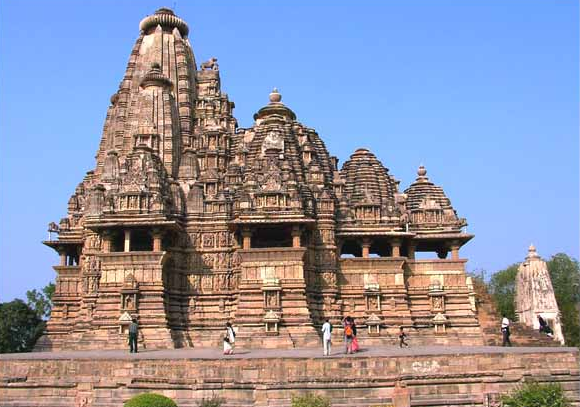
Khajuraho, which has lent its name to a complex of exquisite Hindu and Jain temples, is a small town located amidst the forested plains of Bundelkhand in north-central Madhya Pradesh. The beautiful temples that dot Khajuraho are believed to have been built by the mighty Chandela rulers in the 9th and 10th century AD. The engravings on these temples are highly sensual and erotic that depict in graceful forms intimate scenes of the whole range of human emotions and relationships. These sculptures congeal in stone a lyrical paean to love and passion and reflect the Chandela dynasty/’s immense appreciation for art.
Architecturally, the temples are built in the north Indian Nagara style. The sculptor/’s fine skill and a sense of imagination have given form to human emotion in the form of spiritual and physical love. Every façade—wall, window, pillar, and ceiling—is carved with figures of mythical and historical origins, and while many of these depict full-breasted, girdle-waisted women in forms of innocent play, they also depict carnal love.
In all 85 temples were built in Khajuraho, but only 22 are left to speak of the grandeur of conception of the rulers and architects of the day. The basic ground plan of the temples of Khajuraho is almost a textbook example of Hindu temple architecture consisting of four compartments: an entrance porch (ardhamandap), the vestibule (antarala) and the sanctum sanctorum (garbhagriha). In some of the large temples an extra mandap with lateral transepts is added for size and splendour, converting it into a large assembly hall. The temples rest on a risen open platform, a distinctive feature of the Khajuraho temples, with subsidiary shrines at the four corners of the platform in the bigger temples.
Sightseeing
Khajuraho combines history, architecture, culture and environment with delectable charm. It is a town that takes you away from the noise and pollution of the city, with its fresh air and scenic countryside. For convenience, the temples of Khajuraho are divided into the Western, Eastern, and Southern groups. The Western Group, situated opposite the Government of India Tourist Office, has 14 temples. The Chaunsath Yogini, Lalguan Mahadev, Parvati, Varaha, Matangesvara, Lakshmana, Vishvanath and Nandi, Chitragupta, Devi Jagdamba and Kandariya Mahadeo temples belong to this group. The Eastern Group, 2.4 km from the Tourist Office, consists of seven temples (four Jain and three Hindu). The Parsvanath, Adinath, Shantinath, and Ghantai temples belong to the Jains while the Vamana, Javari and Brahma are Hindu temples. The Southern Group, about 5 km from Khajuraho, contains the Chaturbhuj and Duladeo temples.
Excursions
Even though Khajuraho’s temples are its biggest attraction, there are other interesting sights in its vicinity which can be visited on a daylong trip. There is the Ken Gharial Sanctuary, 120 km away, which is rough and wild, with its gorges, rocks and the lovely Ken River. The Panna National Park, 40 km from Khajuraho, is home to a variety of wildlife. The Dhubela Museum (64 km), on the Jhansi-Khajuraho road, houses the weapons, paintings, and sculptures of the Bundela kings as well as a wide variety of sculptures of the Shakti cult. The Pandav Falls, Raigarh Palace, Bandhavgarh, and Ajaygarh Fort are other important places worth visiting.
Excursions for Khajuraho
Western Group Of Temples
The Western Group of Temples, in the heart of the town, are the most famous temples of Khajuraho, with the mithunas (couples), gandharvas, apsaras, vidyadaras and kinaras. The images of the apsaras are stunning, with their sensuous poses and liquid movements. There are the unforgettable images of a maiden adorning herself before a mirror, applying kohl on her eyes, plaiting her long hair, removing a thorn from her foot. The erotic images, almost acrobatic orgiastic scenes have been associated with Tantric rituals and practices. However, it/’s not so much the sexual aspect but the grace, energy and feeling that strikes one most about these images. The eyes, the face and the body are poetry of pure emotive movement.

The Kandariya Mahadeo is the biggest and most stunning temple, with its 800 statues of gods and goddesses, the marble lingam and the ceiling that rises 31 metres high. It is considered the most evolved example of central Indian temple architecture. Dedicated to Lord Shiva, this temple is also the largest of Khajuraho/’s temples.
The Lakshmana Temple has friezes of battle scenes and erotic poses, depicting both sides of the Chandela warriors/’ lives. In fact, the eight figures on each column are supposed to represent each sect of the Tantric cult. The finely carved inner sanctum has a three-headed idol of Vishnu/’s incarnations, Narasimha and Varaha.
The Varaha Temple has a 9-feet-high image of the boar incarnation of Vishnu, gorgeously carved with 474 images.
The Chitragupta Temple is dedicated to the Sun God, and has many group scenes of royal processions, hunting, and dancing that reflect the lavish lifestyle of the Chandela courts.
The Devi Jagdamba Temple has a gorgeous image of Parvati. It is perhaps the most erotic temple of Khajuraho. The temple houses Khajuraho/’s most talked-about image, mithuna, and the sensuously carved figures. However, till today it is not clear as to which deity this temple is dedicated.
The Matangesvara Temple has a 2.5-metre-high polished lingam of Shiva. This is the only temple that is actively used for worship.
The temple of Vishvanath and Nandi celebrates the marriage of Lord Shiva with Parvati. The temple draws attention by its provocative depiction of women.
Chaunsath Yogini is dedicated to goddesses Kali. It is the oldest of the surviving temples of Khajuraho. The only temple in Khajuraho to be built of granite, the name of the temple is derived from the cells of 64 attendants of Goddess Kali (chaunsath: sixty-four).
The gardens around the Western temples are picturesque and become a spectacle of colour and light during the Khajuraho dance festival.
Eastern Group Of Temples
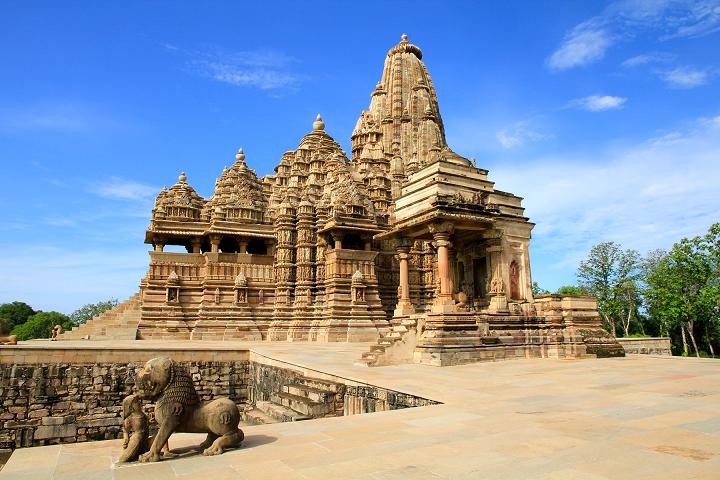
The Eastern temples are partly Jain and partly Hindu. The most striking is the Parsvanath Temple, with its exquisite sculptures depicting everyday activity. There is a bull-emblem of the first Tirthankara, Adinath. It is a fine instance of sensitive art without any sexual motifs. In the vicinity of this temple is the temple of Adinath, which has some fine carvings. The temple is structurally similar to the Hindu temples of Khajuraho. In fact, it is this Jain-Hindu combination that is singularly interesting about the Eastern Group of temples. Only a century old, Shantinath is the most recent of all the temples in Khajuraho. Visited by the Digambar Jains, the temple houses a four and a half metre statue of Adinath.
The Ghantai Temple, mostly in ruins now, has fine columns and chains and bells, with a figure of a Jain goddess on a garuda. Mainly built of granite and sandstone, the temple of Brahma and Hanuman is one of the oldest temples in Khajuraho. Strange though it may seem, the temple is actually dedicated to Lord Vishnu. Close by is a Hanuman temple reputed to have the earliest inscription dating back to AD 922 on a 2½-metre statue. The Javari and Vamana are two other notable temples of the Eastern Group.
The Southern Group Of Temples
The southern group of temples contains only two temples. The Duladeo Temple apparently is newer of the two and was built at a time when the creativity of Khajuraho was well below its peak. The other is the Chaturbhuj Temple, located far from the village. The temple houses a three-metre-high statue of Vishnu.
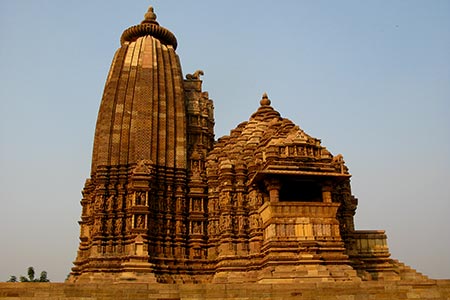
Ajaygarh Fort
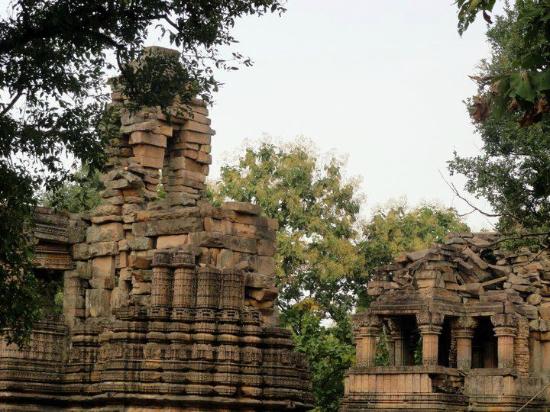
The Ajaygarh Fort is a distance of 80 km from Khajuraho. Built at a height of 688 metres, it was the capital of the Chandelas in their declining years. Another fort is Kalinjar, located on the Vindhya Range at a distance of 100 km. Built during the Gupta period, the fort was captured by Shri Yashovarman, the Chandela king, in the 10th century.
Bandhavgarh
Bandhavgarh, around 237 km from Khajuraho, is situated in the heart of the Vindhya Mountain range. The landscape here is dominated by the 14th-century Bandhavgarh Fort. Besides the fort, there are a large number of caves with inscriptions dating back to the prehistoric period. However, Bandhavgarh is gaining popularity in recent times because of its national park. The first white tiger was sighted here in 1951.

Dhubela Museum

Dhubela Museum is located in a fort, 64 km away from Khajuraho. The museum houses a wide variety of sculpture of the Shakti cult. There are also garments, weapons, and paintings of the Bundela kings.
Pandav Falls
On the Ken River is Pandav Falls, 30 km from Khajuraho. It is believed that the Pandavas spent some years of their exile here, hence the name. Another waterfall, the Ranch, is situated at a distance of 25 km from the Pandav Falls.

Panna National Park
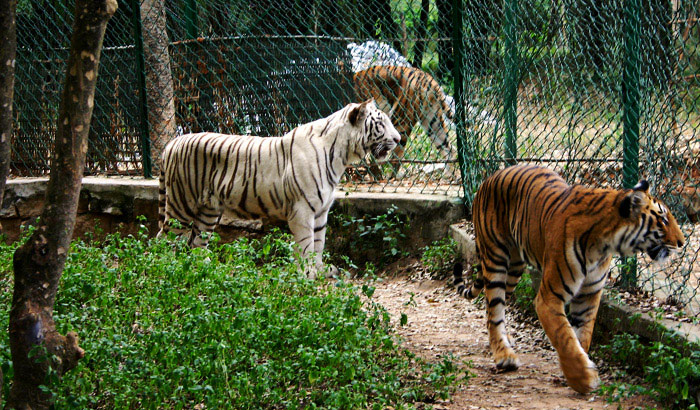
Panna (40 km) is a historical city famous for its temples. It was the erstwhile capital of the Bundela kingdom. However, today it is more renowned for the Panna National Park that is spread over 546 km on the bank of the Ken River. An ideal place for wildlife lovers, the park is visited by thousands of tourists every year. The best time to visit the park is early morning, and drive in an open jeep through the thick, wild vegetation. You can see a variety of birds (blossom-headed parakeet, red-belted cap wing, weaver, tree-pie), antelopes, chinkaras, sambars, and boars. And if you are lucky enough, you can also catch sight of the elusive tiger. Panna also has one of the most famous diamond mines of the world at Majhganwa. The Panna mines are the only working diamond mines in India and the largest in Asia.
Raigarh Palace
The Rajgarh Palace is at the foot of Maniyagarh hills, around 25 km from Khajuraho. Around 150 years old, the palace has been converted into a heritage hotel.
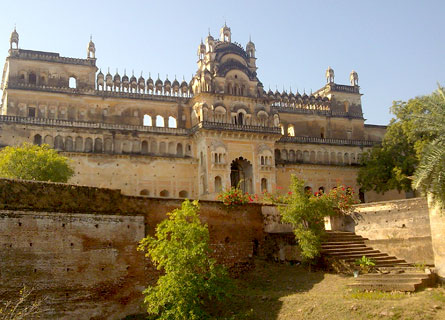
Fact File
 Area: 16.93 sq. km
Area: 16.93 sq. km
 Population: 6,541
Population: 6,541
 Altitude: 257 m above sea level
Altitude: 257 m above sea level
 Best Time to Visit:October to March
Best Time to Visit:October to March
 Languages: Hindi and English
Languages: Hindi and English
 STD Code: 07686
STD Code: 07686




